Search results for: 'air fiber'
- Related search terms
- fiber
- air line h
- air+compr
- air compres
- air+compress
-
 M-3982 AUTEFA LAPPER 3000 X 4500 YEAR 2003 - 100 METERS PER MINUTEREFERENCE NUMBER: M-3982 (9905HKMF8U)-D AUTEFA LAPPER 3000 X 4500 YEAR 2003 - 100 METERS PER MINUTE AUTEFA CROSSLAPPER 100 METERS PER MINUTE YEAR 2003 3000 X 4500 QUANTITY AVAILABLE: 1 Learn More
M-3982 AUTEFA LAPPER 3000 X 4500 YEAR 2003 - 100 METERS PER MINUTEREFERENCE NUMBER: M-3982 (9905HKMF8U)-D AUTEFA LAPPER 3000 X 4500 YEAR 2003 - 100 METERS PER MINUTE AUTEFA CROSSLAPPER 100 METERS PER MINUTE YEAR 2003 3000 X 4500 QUANTITY AVAILABLE: 1 Learn More -
 F-1362 PILLOW WEIGHT SETTING VACUUM FILLING MACHINEREFERENCE NUMBER: F-1362 PILLOW WEIGHT SETTING VACUUM FILLING MACHINE THE VACUUM FILLING MACHINE IS FOR FABRIC PILLOW AND CUSHION FILLING. SUITABLE MATERIAL IS SILICONIZED STAPLE FIBER. THE VACUUM FILLING MACHINE IS EQUIPPED WITH A FREQUENCY CONVERTER. THE FILLING SPEED IS ADJUSTABLE TO THE FILLING SURFACE IS VERY EVEN. THE FILLING IS CARRIED OUT BY "SUCTION", NOT THE TRADITIONAL "BLOW", WHICH CAN MAKE FILLING MATERIALS GO IN ALL DIRECTIONS AND COME TO THE 4 CORNERS OF THE PILLOW OR CUSHION. THE AFTER-FILLING EFFECT WITH BE BETTER THAN ALL OTHER FILLING. THE LINE CAN SET THE WEIGHT FOR EACH PILLOW/CUSHION APPROXIMATELY. FIBER CARDING MACHINE: DIMENSIONS: 2150 X 900 X 940mm POWER: 4.75kW NET WEIGHT: 600kg FIBER SUCTION AND SILENSOR: DIMENSIONS: 700 X 930 X 2450mm POWER: 7.5kW AIR PRESSURE: 1mpa NET WEIGHT: 300kg VACUUM FILLING MACHINE: DIMENSIONS: 2990 X 1700 X 2450mm AIR PRESSURE: 1mpa NET WEIGHT: 400kg QUANTITY AVAILABLE: 1 Learn More
F-1362 PILLOW WEIGHT SETTING VACUUM FILLING MACHINEREFERENCE NUMBER: F-1362 PILLOW WEIGHT SETTING VACUUM FILLING MACHINE THE VACUUM FILLING MACHINE IS FOR FABRIC PILLOW AND CUSHION FILLING. SUITABLE MATERIAL IS SILICONIZED STAPLE FIBER. THE VACUUM FILLING MACHINE IS EQUIPPED WITH A FREQUENCY CONVERTER. THE FILLING SPEED IS ADJUSTABLE TO THE FILLING SURFACE IS VERY EVEN. THE FILLING IS CARRIED OUT BY "SUCTION", NOT THE TRADITIONAL "BLOW", WHICH CAN MAKE FILLING MATERIALS GO IN ALL DIRECTIONS AND COME TO THE 4 CORNERS OF THE PILLOW OR CUSHION. THE AFTER-FILLING EFFECT WITH BE BETTER THAN ALL OTHER FILLING. THE LINE CAN SET THE WEIGHT FOR EACH PILLOW/CUSHION APPROXIMATELY. FIBER CARDING MACHINE: DIMENSIONS: 2150 X 900 X 940mm POWER: 4.75kW NET WEIGHT: 600kg FIBER SUCTION AND SILENSOR: DIMENSIONS: 700 X 930 X 2450mm POWER: 7.5kW AIR PRESSURE: 1mpa NET WEIGHT: 300kg VACUUM FILLING MACHINE: DIMENSIONS: 2990 X 1700 X 2450mm AIR PRESSURE: 1mpa NET WEIGHT: 400kg QUANTITY AVAILABLE: 1 Learn More -
 P-5079 COMMERCIAL JOPER CAST IRON CRM-30 ROASTER 30 KILOS
P-5079 COMMERCIAL JOPER CAST IRON CRM-30 ROASTER 30 KILOSP-5079 COMMERCIAL JOPER CAST IRON CRM-30 ROASTER 30 KILOS
WHAT WE HAVE HERE IS A VERY RUGGED CAST IRON ROASTING FRAME AND ROASTING CONTACT CLEARANCES WITH THE MACHINE - JUST PLAIN SOLID AND DOES NOT MOVE UNDER LONG OR EXTENDED USE. DOUBLE WALL DRUM MEANS THAT THE HEAT IS ALL DESIGNED TO GO THROUGH THE CENTER OF THE ROASTING CHAMBER, NOT "ONTO" THE DRUM EXTERIOR. TOTAL TRUE CONVECTION. NOT ONLY IS THIS THE SAME STYLE FROM THE OLD GOTHOT & BARTH ROASTER DAYS. . . BUT EVEN BETTER AS THE SHAFT DESIGN SO THAT BEARINGS ARE EXTERNALLY MOUNTED AND ADDITIONALLY ARE AIR COOLED FOR LONG LIFE AND TROUBLE-FREE CONTROL. EVEN THE SIDE PANELS OR PRODUCT FLIGHTS HAVE A LONGER CURVE POSITIONING MORE PRODUCT FLOW INTO THE HOT AIR STREAM, RESULTING IN A SLIGHTLY MORE RAPID ROAST WITH MORE EVEN BEAN INTERIOR AND EXPANSION THAT FRANKLY LEADS THE INDUSTRY.
ALL THIS COMMENTARY ABOVE MEANS THIS ROASTER SIMPLY IS MORE QUIET THAN ANYTHING ON THE MARKET. PERIOD. THERMAL INSULATION WITH HIGHEST QUALITY OF FIBER FOR LOW GAS CONSUMPTION; DIGITAL TEMPERATURE CONTROL. CYCLONE IS SEPARATE. THE COOLER, BEING TOTALLY SEPARATE ALSO HAS THE LARGEST AIR COLLECTION AREA OF ANY ROASTER MADE ALLOWING FOR TOTAL AMBIENT COOL COFFEE IN LESS THAN THREE MINUTES. ADD TO THIS PACKAGE A LOADER OR YOUR CHOICE OF DESTONERS AND EVEN YOUR CHOICE OF CONTROL METHODS.
DATA INFORMATION:
BATCH CAPACITY: 30 KG / 66 LBS
CONTROL DESIGN: MANUAL
CAPACITY PER HOUR: 120 KG / 265 LBS
ROASTING TIME: 12-18 MIN (4 BATCHES AN HOUR)
EXHAUST AIR TREATMENT: OPTIONAL
COOLING CYCLONE: OPTIONAL
PRE-COOLING WITH WATER IN DRUM: OPTIONAL
COOLING TIME: 3-4 MIN
TYPE OF COOLING: AIR AMBIENT
SAFETY DEVICE: YES
BURNER POWER: 110 KW / 375000 BTU
BURNERS MANUFACTURER: RIELLO
OPERATION TYPE BURNER: BS2D-2 STAGE
FUEL TYPE: PROPANE/NAUTRAL GAS/DIESEL
SIDE OF OPERATION: LEFT
POWER REQUIREMENTS: 20 AMP
VOLTAGE/FREQUENCY/PHASES: 400+N-230 V / 50-60 HZ / 3 PH
9 AMP. . . 3 PHASE 50/60 HZ PREFERRED, YOUR CHOICE OF 220/440 - SINGLE PHASE AVAILABLE AT SPECIAL REQUEST
(NOTE ON 3 PHASE. . . NOT ONLY IS IT LESS EXPENSIVE TO OPERATE, BUT IT RUNS MORE QUIETLY THAN SINGLE PHASE WHENEVER OR WHEREVER IT IS USED. KEEP THIS IN MIND FOR ANY MACHINERY.)
Ø EXHAUST CHIMNEY (ROASTER CYCLONE): 250MM / 9,8 INCH
Ø EXHAUST CHIMNEY (COOLER): 250MM / 9,8 INCH
Ø HOPPER ROAST CHIMNEY: 150MM / 5,9 INCH
ROASTER WEIGHT WITH CYCLONE: 1050 KG / 2310 LBS
COOLER WEIGHT: 300 KG / 660 LBS
ROASTER FAN MOTOR: 1, 5 HP
COOLER FAN: 4 HP
DRUM GEARBOX: 1 HP
COOLER GEARBOX: 0, 75 HP
BUILT TO UL295 STANDARDS.QUANTITY: 1
Learn More -
 TT-6338 COMPLETE PULP MILL SOLD IN SECTIONS-PARTS, CAPACITY 350,000 TPYTT-6338 COMPLETE PULP MILL SOLD IN SECTIONS-PARTS, CAPACITY 350,000 TPY 1. IN GOOD WORKING CONDITION 2. STOPPED 2023 3. EQUIPMENT NOT AVAILABLE FOR LONG 4. COMPLETE PULP MILL. Learn More
TT-6338 COMPLETE PULP MILL SOLD IN SECTIONS-PARTS, CAPACITY 350,000 TPYTT-6338 COMPLETE PULP MILL SOLD IN SECTIONS-PARTS, CAPACITY 350,000 TPY 1. IN GOOD WORKING CONDITION 2. STOPPED 2023 3. EQUIPMENT NOT AVAILABLE FOR LONG 4. COMPLETE PULP MILL. Learn More -
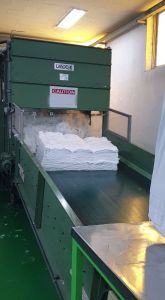 TT-1443 COMPLETE SPUNLACE LINE, WORKING WIDTH 3500mm, YEAR 2000TT-1443 COMPLETE SPUNLACE LINE, WORKING WIDTH 3500mm, YEAR 2000 ITEM 001 LAROCHE OPENING & BLENDING SET (COMPRISING OF 4 BALE HOPPER, SET OF FINE OPENER AND FIBRE CONVEYING SYSTEM) QUANTITY: 1 ITEM 002 THIBEAU CARD CA11, WORKING WIDTH 3000mm QUANTITY: 1 ITEM 003 ASSELIN CROSSLAPPER QUANTITY: 1 ITEM 004 RIETER- PERFOJET SPUNLACE MACHINE 3 CYLINDERS/7 INJECTORS WORKING WIDTH 3600mm QUANTITY: 1 ITEM 005 FLEISSNER DRUM DRYER, WORKING WIDTH 3600mm QUANTITY: 1 ITEM 006 BASTIAN AUTOMATIC WINDER, WORKING WIDTH 3600mm QUANTITY: 1 ITEM 007 THIBEAU CARD FEEDER QUANTITY: 1 ITEM 008 ASSELIN WEB-DRAFTER WORKING WIDTH 4400mm QUANTITY: 1 ITEM 009 LOT ELECTRICAL CONTROLS 380V/50Hz QUANTITY: 1 ITEM 010 LOT AUXILIARY EQUIPMENT FOR THE SPUNLACE UNIT QUANTITY: 1 YEAR 2000 DRYER: 8 TYPE, 2 DRUMS Learn More
TT-1443 COMPLETE SPUNLACE LINE, WORKING WIDTH 3500mm, YEAR 2000TT-1443 COMPLETE SPUNLACE LINE, WORKING WIDTH 3500mm, YEAR 2000 ITEM 001 LAROCHE OPENING & BLENDING SET (COMPRISING OF 4 BALE HOPPER, SET OF FINE OPENER AND FIBRE CONVEYING SYSTEM) QUANTITY: 1 ITEM 002 THIBEAU CARD CA11, WORKING WIDTH 3000mm QUANTITY: 1 ITEM 003 ASSELIN CROSSLAPPER QUANTITY: 1 ITEM 004 RIETER- PERFOJET SPUNLACE MACHINE 3 CYLINDERS/7 INJECTORS WORKING WIDTH 3600mm QUANTITY: 1 ITEM 005 FLEISSNER DRUM DRYER, WORKING WIDTH 3600mm QUANTITY: 1 ITEM 006 BASTIAN AUTOMATIC WINDER, WORKING WIDTH 3600mm QUANTITY: 1 ITEM 007 THIBEAU CARD FEEDER QUANTITY: 1 ITEM 008 ASSELIN WEB-DRAFTER WORKING WIDTH 4400mm QUANTITY: 1 ITEM 009 LOT ELECTRICAL CONTROLS 380V/50Hz QUANTITY: 1 ITEM 010 LOT AUXILIARY EQUIPMENT FOR THE SPUNLACE UNIT QUANTITY: 1 YEAR 2000 DRYER: 8 TYPE, 2 DRUMS Learn More -
 TT-1316 NONWOVEN MIDDLE SPEED NEEDLE LOOM, WORKING WIDTH 3200mmTT-1316 NONWOVEN MIDDLE SPEED NEEDLE LOOM, WORKING WIDTH 3200mm MACHINE STRUCTURE FEATURES: 1. SPLICING TYPE STRUCTURE, IT IS MADE BY HIGH QUALITY Q235 STEEL PLATE WELDING, THEN FINE TEMPERING QUALITATIVELY WITH SUFFICIENT COMPLETENESS AND STABILITY. UPPER AND DOWN MACHINE GIRDERS BOTH PRECISELY PROCESSING MACHINED. 2. ECCENTRIC BEARINGS ADOPT TORRINGTON FAMOUS BRAND 3. MAIN SHAFT IS USING 42CROMO MATERIAL. AFTER CONDITIONING TREATMENT FINE FINISHING AND GRINDING. 4. NEEDLE GIRDER HIGH SPEED TURBINE ELECTRIC LIFTING, STRIPPER PLATE TURBINE ELECTRIC LIFTING, NEEDLE GIRDER ROLLER SCALE DISPLAY. AIR LOCKED THE NEEDLE PLATE TIGHTLY. 5. NEEDLE PLATE LUOYANG MADE BY MAGNESIUM ALLOY DIE CASTING PLATE COMPOSITE PU, RADON ARRANGE NEEDLES HOLE φ1.82mm 6. INPUT PVC LATTICE, OUTPUT ROLLER ADOPTS φ155mm, HIGH QUALITY SEAMLESS STEEL PIPE, AFTER FINISHING GRINDING, THE SURFACE IS PLATED WITH HARD CHROME, UPPER ROLLER ADJUSTABLE HEIGHT AIR CYLINDER. 7. MAIN MOTOR, OUTPUT ROLLER ALL FREQUENCY CONTROL. 8. INSTALLED POWER: AROUND 15.5KW, MAIN MOTOR 11 KW. QUANTITY: 1 SET Learn More
TT-1316 NONWOVEN MIDDLE SPEED NEEDLE LOOM, WORKING WIDTH 3200mmTT-1316 NONWOVEN MIDDLE SPEED NEEDLE LOOM, WORKING WIDTH 3200mm MACHINE STRUCTURE FEATURES: 1. SPLICING TYPE STRUCTURE, IT IS MADE BY HIGH QUALITY Q235 STEEL PLATE WELDING, THEN FINE TEMPERING QUALITATIVELY WITH SUFFICIENT COMPLETENESS AND STABILITY. UPPER AND DOWN MACHINE GIRDERS BOTH PRECISELY PROCESSING MACHINED. 2. ECCENTRIC BEARINGS ADOPT TORRINGTON FAMOUS BRAND 3. MAIN SHAFT IS USING 42CROMO MATERIAL. AFTER CONDITIONING TREATMENT FINE FINISHING AND GRINDING. 4. NEEDLE GIRDER HIGH SPEED TURBINE ELECTRIC LIFTING, STRIPPER PLATE TURBINE ELECTRIC LIFTING, NEEDLE GIRDER ROLLER SCALE DISPLAY. AIR LOCKED THE NEEDLE PLATE TIGHTLY. 5. NEEDLE PLATE LUOYANG MADE BY MAGNESIUM ALLOY DIE CASTING PLATE COMPOSITE PU, RADON ARRANGE NEEDLES HOLE φ1.82mm 6. INPUT PVC LATTICE, OUTPUT ROLLER ADOPTS φ155mm, HIGH QUALITY SEAMLESS STEEL PIPE, AFTER FINISHING GRINDING, THE SURFACE IS PLATED WITH HARD CHROME, UPPER ROLLER ADJUSTABLE HEIGHT AIR CYLINDER. 7. MAIN MOTOR, OUTPUT ROLLER ALL FREQUENCY CONTROL. 8. INSTALLED POWER: AROUND 15.5KW, MAIN MOTOR 11 KW. QUANTITY: 1 SET Learn More -
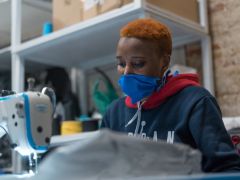 D-2388 What’s the Best Material for a Mask?
D-2388 What’s the Best Material for a Mask?Federal health officials have now recommended that we cover our faces with fabric during the coronavirus pandemic. But what material offers the most protection?
The Centers for Disease Control and Prevention has posted a no-sew mask pattern using a bandanna and a coffee filter as well as a video on making masks using rubber bands and folded fabrics found at home.
While a simple face covering can reduce the spread of coronavirus by blocking outgoing germs from coughs or sneezes of an infected person, experts say there is more variation in how much homemade masks might protect the wearer from incoming germs, depending on the fit and quality of the material used.
Scientists around the country have taken it upon themselves to identify everyday materials that do a better job of filtering microscopic particles. In recent tests, HEPA furnace filters scored well, as did vacuum cleaner bags, layers of 600-count pillowcases and fabric similar to flannel pajamas. Stacked coffee filters had medium scores. Scarves and bandanna material had the lowest scores, but still captured a small percentage of particles.
If you don’t have any of the materials that were tested, a simple light test can help you decide whether a fabric is a good candidate for a mask.
“Hold it up to a bright light,” said Dr. Scott Segal, chairman of anesthesiology at Wake Forest Baptist Health who recently studied homemade masks. “If light passes really easily through the fibers and you can almost see the fibers, it’s not a good fabric. If it’s a denser weave of thicker material and light doesn’t pass through it as much, that’s the material you want to use.”
Researchers say it’s important to remember that lab studies are conducted under perfect conditions with no leaks or gaps in the mask, but the test methods give us a way to compare materials. And while the degree of filtration for some homemade masks seems low, most of us — who are staying home and practicing social distancing in public — don’t need the high level of protection required for medical workers. More important, any face covering is better than none, especially if worn by a person who has the virus but doesn’t know it.
The biggest challenge of choosing a homemade mask material is to find a fabric that is dense enough to capture viral particles, but breathable enough that we can actually wear it. Some items being touted online promise high filtration scores, but the material would be unwearable.
Dressing Up for Work … at Home
Yang Wang, an assistant professor of environmental engineering at Missouri University of Science and Technology, worked with his graduate students to study various combinations of layered materials — including both air filters and fabric. “You need something that is efficient for removing particles, but you also need to breathe,” said Dr. Wang, who last fall won an international award for aerosol research.To test everyday materials, scientists are using methods similar to those used to test medical masks, which everybody agrees should be saved for medical workers who are exposed to high doses of virus from seeing infected patients. The best medical mask — called the N95 respirator — filters out at least 95 percent of particles as small as 0.3 microns. By comparison, a typical surgical mask — made using a rectangular piece of pleated fabric with elastic ear loops — has a filtration efficiency ranging from 60 to 80 percent.
Dr. Wang’s group tested two types of air filters. An allergy-reduction HVAC filter worked the best, capturing 89 percent of particles with one layer and 94 percent with two layers. A furnace filter captured 75 percent with two layers, but required six layers to achieve 95 percent. To find a filter similar to those tested, look for a minimum efficiency reporting value (MERV) rating of 12 or higher or a microparticle performance rating of 1900 or higher.
The problem with air filters is that they potentially could shed small fibers that would be risky to inhale. So if you want to use a filter, you need to sandwich the filter between two layers of cotton fabric. Dr. Wang said one of his grad students made his own mask by following the instructions in the C.D.C. video, but adding several layers of filter material inside a bandanna.
Dr. Wang’s group also found that when certain common fabrics were used, two layers offered far less protection than four layers. A 600 thread count pillow case captured just 22 percent of particles when doubled, but four layers captured nearly 60 percent. A thick woolen yarn scarf filtered 21 percent of particles in two layers, and 48.8 percent in four layers. A 100 percent cotton bandanna did the worst, capturing only 18.2 percent when doubled, and just 19.5 percent in four layers.
The group also tested Brew Rite and Natural Brew basket-style coffee filters, which, when stacked in three layers, showed 40 to 50 percent filtration efficiency — but they were less breathable than other options.
If you are lucky enough to know a quilter, ask them to make you a mask. Tests performed at the Wake Forest Institute for Regenerative Medicine in Winston-Salem, N.C., showed good results for homemade masks using quilting fabric. Dr. Segal, of Wake Forest Baptist Health, who led the study, noted that quilters tend to use high-quality, high-thread count cotton. The best homemade masks in his study were as good as surgical masks or slightly better, testing in the range of 70 to 79 percent filtration. Homemade masks that used flimsier fabric tested as low as 1 percent filtration, Dr. Segal said.
The best-performing designs were a mask constructed of two layers of high-quality, heavyweight “quilter’s cotton,” a two-layer mask made with thick batik fabric, and a double-layer mask with an inner layer of flannel and outer layer of cotton.
Bonnie Browning, executive show director for the American Quilter’s Society, said that quilters prefer tightly woven cottons and batik fabrics that stand up over time. Ms. Browning said most sewing machines can handle only two layers of fabric when making a pleated mask, but someone who wanted four layers of protection could wear two masks at a time.
Ms. Browning said she recently reached out to quilters on Facebook and heard from 71 people who have made a combined total of nearly 15,000 masks. “We quilters are very much in the thick of what’s going on with this,” said Ms. Browning, who lives in Paducah, Ky. “One thing most of us have is a stash of fabric.”
People who don’t sew could try a folded origami mask, created by Jiangmei Wu, assistant professor of interior design at Indiana University. Ms. Wu, who is known for her breathtaking folded artwork, said she began designing a folded mask out of a medical and building material called Tyvek, as well as vacuum bags, after her brother in Hong Kong, where mask wearing is common, suggested it. (DuPont, the maker of Tyvek, said in a statement that Tyvek is intended for medical apparel, not masks.) The folded mask pattern is free online, as is a video demonstrating the folding process. In tests at Missouri University and University of Virginia, scientists found that vacuum bags removed between 60 percent and 87 percent of particles. But some brands of vacuum bags may contain fiberglass or are harder to breathe through than other materials, and shouldn’t be used. Ms. Wu used a bag by EnviroCare Technologies, which has said it does not use fiberglass in its paper and synthetic cloth bags.
“I wanted to create an alternative for people who don’t sew,” said Ms. Wu, who said she is talking to various groups to find other materials that will be effective in a folded mask. “Given the shortage of all kinds of materials, even vacuum bags might run out.”
The scientists who conducted the tests used a standard of 0.3 microns because that is the measure used by the National Institute for Occupational Safety and Health for medical masks.
Linsey Marr, a Virginia Tech aerosol scientist and an expert in the transmission of viruses, said the certification method for respirators and HEPA filters focuses on 0.3 microns because particles around that size are the hardest to catch. While it seems counterintuitive, particles smaller than 0.1 microns are actually easier to catch because they have a lot of random motion that makes them bump into the filter fibers, she said.
“Even though coronavirus is around 0.1 microns, it floats around in a wide range of sizes, from around 0.2 to several hundred microns, because people shed the virus in respiratory fluid droplets that also contain lots of salts and proteins and other things,” said Dr. Marr. “Even if the water in the droplets fully evaporates, there’s still a lot of salt and proteins and other gunk that stays behind as solid or gel-like material. I think 0.3 microns is still useful for guidance because the minimum filtration efficiency will be somewhere around this size, and it’s what NIOSH uses.”
Learn More -
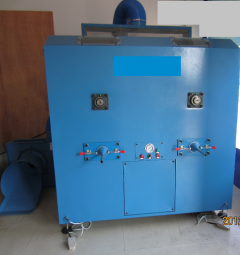 K-3843 KAPOK FILLING MACHINEREFERENCE NUMBER: K-3843 KAPOK FILLING MACHINE STUFFING MACHINE AND BLOWER KAPOK FEEDING HOPPER AIR COMPRESSOR QUANTITY AVAILABLE: 1 Learn More
K-3843 KAPOK FILLING MACHINEREFERENCE NUMBER: K-3843 KAPOK FILLING MACHINE STUFFING MACHINE AND BLOWER KAPOK FEEDING HOPPER AIR COMPRESSOR QUANTITY AVAILABLE: 1 Learn More -
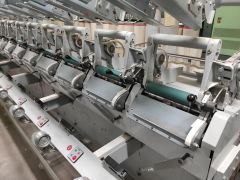 TT-3389 RITE MODEL ARD-L TWISTER MACHINE WITH 32 SPINDLES, YEAR 2013TT-3389 RITE MODEL ARD-L TWISTER MACHINE WITH 32 SPINDLES, YEAR 2013 BRAND: RITE MODEL: ARD-L YEAR: 2013 32 SPINDLES 440V 60Hz DELIVERY: CLYINDRICAL CYLINDER IS 194mm LONG AND 50mm IN DIAMETER FOR COTTON BUT SHOULD BE POSSIBLE TO WORK OTHER FIBERS AND FILAMENT DELIVERY SPEED: UP TO 800 METERS PER MINUTE QUANTITY: 1 Learn More
TT-3389 RITE MODEL ARD-L TWISTER MACHINE WITH 32 SPINDLES, YEAR 2013TT-3389 RITE MODEL ARD-L TWISTER MACHINE WITH 32 SPINDLES, YEAR 2013 BRAND: RITE MODEL: ARD-L YEAR: 2013 32 SPINDLES 440V 60Hz DELIVERY: CLYINDRICAL CYLINDER IS 194mm LONG AND 50mm IN DIAMETER FOR COTTON BUT SHOULD BE POSSIBLE TO WORK OTHER FIBERS AND FILAMENT DELIVERY SPEED: UP TO 800 METERS PER MINUTE QUANTITY: 1 Learn More -
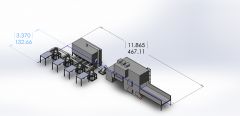 E-4401-4 NOZZLE NEW PILLOW FILLING MACHINE (4 NOZZLE): FOR 3 DENIER x 51mm SILICONIZED VIRGIN FIBERE-4401-4 NOZZLE NEW PILLOW FILLING MACHINE (4 NOZZLE): FOR 3 DENIER x 51mm SILICONIZED VIRGIN FIBER FOR POLYESTER STAPLE FIBER OPENING AND FILLING INTO UPHOLSTERY CUSHIONS OR PILLOWS. CAPACITY 250 KGS PER HOUR X 400 HOURS PER MONTH = 100,000 KGS PER MONTH AT 100% EFFICIENCY HOPPER FEED (REF G-3768) WITH 4.5 KW MOTOR FIBER OPENER TRANSFER FAN MIXING MACHINE (SILO WITH FOUR EXITS) FILLING STATION (FAN) , FOUR FILLING FANS WITH NOZZLE CLAMPS AND WITH TABLES SPARE PARTS SUGGESTED Learn More
E-4401-4 NOZZLE NEW PILLOW FILLING MACHINE (4 NOZZLE): FOR 3 DENIER x 51mm SILICONIZED VIRGIN FIBERE-4401-4 NOZZLE NEW PILLOW FILLING MACHINE (4 NOZZLE): FOR 3 DENIER x 51mm SILICONIZED VIRGIN FIBER FOR POLYESTER STAPLE FIBER OPENING AND FILLING INTO UPHOLSTERY CUSHIONS OR PILLOWS. CAPACITY 250 KGS PER HOUR X 400 HOURS PER MONTH = 100,000 KGS PER MONTH AT 100% EFFICIENCY HOPPER FEED (REF G-3768) WITH 4.5 KW MOTOR FIBER OPENER TRANSFER FAN MIXING MACHINE (SILO WITH FOUR EXITS) FILLING STATION (FAN) , FOUR FILLING FANS WITH NOZZLE CLAMPS AND WITH TABLES SPARE PARTS SUGGESTED Learn More
